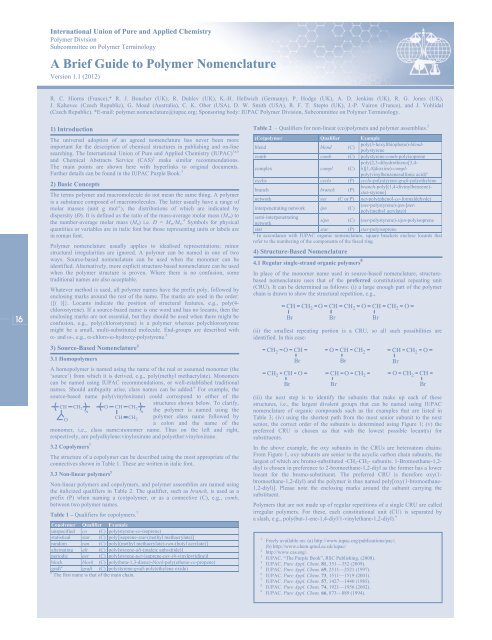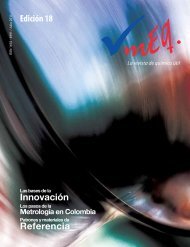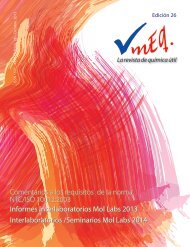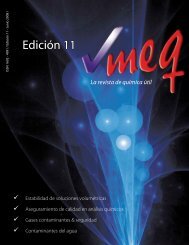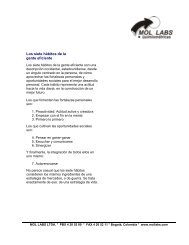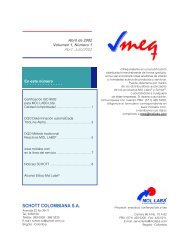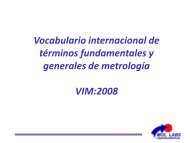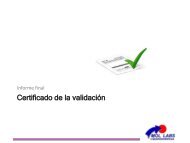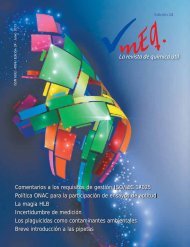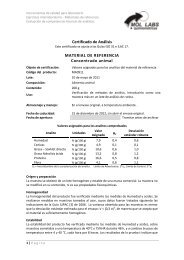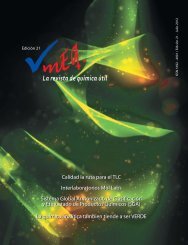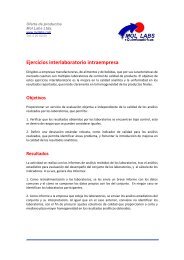mEq 22 - Mollabs
mEq 22 - Mollabs
mEq 22 - Mollabs
You also want an ePaper? Increase the reach of your titles
YUMPU automatically turns print PDFs into web optimized ePapers that Google loves.
International Union of Pure and Applied Chemistry<br />
Polymer Division<br />
Subcommittee on Polymer Terminology<br />
A Brief Guide to Polymer Nomenclature<br />
Version 1.1 (2012)<br />
R. C. Hiorns (France),* R. J. Boucher (UK), R. Duhlev (UK), K.-H. Hellwich (Germany), P. Hodge (UK), A. D. Jenkins (UK), R. G. Jones (UK),<br />
J. Kahovec (Czech Republic), G. Moad (Australia), C. K. Ober (USA), D. W. Smith (USA), R. F. T. Stepto (UK), J.-P. Vairon (France), and J. Vohlídal<br />
(Czech Republic). *E-mail: polymer.nomenclature@iupac.org; Sponsoring body: IUPAC Polymer Division, Subcommittee on Polymer Terminology.<br />
16<br />
1) Introduction<br />
The universal adoption of an agreed nomenclature has never been more<br />
important for the description of chemical structures in publishing and on-line<br />
searching. The International Union of Pure and Applied Chemistry (IUPAC) 1a,b<br />
and Chemical Abstracts Service (CAS) 2 make similar recommendations.<br />
The main points are shown here with hyperlinks to original documents.<br />
Further details can be found in the IUPAC Purple Book. 3<br />
2) Basic Concepts<br />
The terms polymer and macromolecule do not mean the same thing. A polymer<br />
is a substance composed of macromolecules. The latter usually have a range of<br />
molar masses (unit g mol -1 ), the distributions of which are indicated by<br />
dispersity (Đ). It is defined as the ratio of the mass-average molar mass (M m) to<br />
the number-average molar mass (M n) i.e. Đ = M m/M n. 4 Symbols for physical<br />
quantities or variables are in italic font but those representing units or labels are<br />
in roman font.<br />
Polymer nomenclature usually applies to idealised representations; minor<br />
structural irregularities are ignored. A polymer can be named in one of two<br />
ways. Source-based nomenclature can be used when the monomer can be<br />
identified. Alternatively, more explicit structure-based nomenclature can be used<br />
when the polymer structure is proven. Where there is no confusion, some<br />
traditional names are also acceptable.<br />
Whatever method is used, all polymer names have the prefix poly, followed by<br />
enclosing marks around the rest of the name. The marks are used in the order:<br />
{[( )]}. Locants indicate the position of structural features, e.g., poly(4-<br />
chlorostyrene). If a source-based name is one word and has no locants, then the<br />
enclosing marks are not essential, but they should be used when there might be<br />
confusion, e.g., poly(chlorostyrene) is a polymer whereas polychlorostyrene<br />
might be a small, multi-substituted molecule. End-groups are described with<br />
α- and ω-, e.g., α-chloro-ω-hydroxy-polystyrene. 3<br />
3) Source-Based Nomenclature 5<br />
3.1 Homopolymers<br />
A homopolymer is named using the name of the real or assumed monomer (the<br />
‘source’) from which it is derived, e.g., poly(methyl methacrylate). Monomers<br />
can be named using IUPAC recommendations, or well-established traditional<br />
names. Should ambiguity arise, class names can be added. 6 For example, the<br />
source-based name poly(vinyloxirane) could correspond to either of the<br />
CH CH 2<br />
n<br />
O<br />
O<br />
CH CH 2 n<br />
CH CH 2<br />
<br />
structures shown below. To clarify,<br />
the polymer is named using the<br />
polymer class name followed by<br />
a colon and the name of the<br />
monomer, i.e., class name:monomer name. Thus on the left and right,<br />
respectively, are polyalkylene:vinyloxirane and polyether:vinyloxirane.<br />
3.2 Copolymers 7<br />
The structure of a copolymer can be described using the most appropriate of the<br />
connectives shown in Table 1. These are written in italic font.<br />
3.3 Non-linear polymers 5<br />
Non-linear polymers and copolymers, and polymer assemblies are named using<br />
the italicized qualifiers in Table 2. The qualifier, such as branch, is used as a<br />
prefix (P) when naming a (co)polymer, or as a connective (C), e.g., comb,<br />
between two polymer names.<br />
Table 1 – Qualifiers for copolymers. 7<br />
Copolymer Qualifier Example<br />
unspecified co (C) poly(styrene-co-isoprene)<br />
statistical stat (C) poly[isoprene-stat-(methyl methacrylate)]<br />
random ran (C) poly[(methyl methacrylate)-ran-(butyl acrylate)]<br />
alternating alt (C) poly[styrene-alt-(maleic anhydride)]<br />
periodic per (C) poly[styrene-per-isoprene-per-(4-vinylpyridine)]<br />
block block (C) poly(buta-1,3-diene)-block-poly(ethene-co-propene)<br />
graft a graft (C) polystyrene-graft-poly(ethylene oxide)<br />
a The first name is that of the main chain.<br />
Table 2 – Qualifiers for non-linear (co)polymers and polymer assemblies. 5<br />
(Co)polymer Qualifier Example<br />
blend blend (C)<br />
poly(3-hexylthiophene)-blendpolystyrene<br />
comb comb (C) polystyrene-comb-polyisoprene<br />
complex compl (C)<br />
poly(2,3-dihydrothieno[3,4-<br />
b][1,4]dioxine)-complpoly(vinylbenzenesulfonic<br />
acid) a<br />
cyclic cyclo (P) cyclo-polystyrene-graft-polyethylene<br />
branch branch (P)<br />
branch-poly[(1,4-divinylbenzene)-<br />
stat-styrene]<br />
network net (C or P) net-poly(phenol-co-formaldehyde)<br />
interpenetrating network ipn (C)<br />
(net-polystyrene)-ipn-[netpoly(methyl<br />
acrylate)]<br />
semi-interpenetrating<br />
network<br />
sipn (C) (net-polystyrene)-sipn-polyisoprene<br />
star star (P) star-polyisoprene<br />
a In accordance with IUPAC organic nomenclature, square brackets enclose locants that<br />
refer to the numbering of the components of the fused ring.<br />
4) Structure-Based Nomenclature<br />
4.1 Regular single-strand organic polymers 8<br />
In place of the monomer name used in source-based nomenclature, structurebased<br />
nomenclature uses that of the preferred constitutional repeating unit<br />
(CRU). It can be determined as follows: (i) a large enough part of the polymer<br />
chain is drawn to show the structural repetition, e.g.,<br />
CH<br />
Br<br />
CH 2 O CH<br />
Br<br />
CH 2 O CH<br />
Br<br />
CH 2<br />
(ii) the smallest repeating portion is a CRU, so all such possibilities are<br />
identified. In this case:<br />
CH 2 O CH<br />
Br<br />
O<br />
CH<br />
Br<br />
CH 2<br />
CH 2 CH O CH O CH 2<br />
Br<br />
Br<br />
CH<br />
Br<br />
O<br />
CH 2<br />
O<br />
O CH 2 CH<br />
Br<br />
(iii) the next step is to identify the subunits that make up each of these<br />
structures, i.e., the largest divalent groups that can be named using IUPAC<br />
nomenclature of organic compounds such as the examples that are listed in<br />
Table 3; (iv) using the shortest path from the most senior subunit to the next<br />
senior, the correct order of the subunits is determined using Figure 1; (v) the<br />
preferred CRU is chosen as that with the lowest possible locant(s) for<br />
substituents.<br />
In the above example, the oxy subunits in the CRUs are heteroatom chains.<br />
From Figure 1, oxy subunits are senior to the acyclic carbon chain subunits, the<br />
largest of which are bromo-substituted -CH 2-CH 2- subunits. 1-Bromoethane-1,2-<br />
diyl is chosen in preference to 2-bromoethane-1,2-diyl as the former has a lower<br />
locant for the bromo-substituent. The preferred CRU is therefore oxy(1-<br />
bromoethane-1,2-diyl) and the polymer is thus named poly[oxy(1-bromoethane-<br />
1,2-diyl)]. Please note the enclosing marks around the subunit carrying the<br />
substituent.<br />
Polymers that are not made up of regular repetitions of a single CRU are called<br />
irregular polymers. For these, each constitutional unit (CU) is separated by<br />
a slash, e.g., poly(but-1-ene-1,4-diyl/1-vinylethane-1,2-diyl). 9<br />
1<br />
2<br />
3<br />
4<br />
5<br />
6<br />
7<br />
8<br />
9<br />
Freely available on: (a) http://www.iupac.org/publications/pac/;<br />
(b) http://www.chem.qmul.ac.uk/iupac/<br />
http://www.cas.org/.<br />
IUPAC. “The Purple Book”, RSC Publishing, (2008).<br />
IUPAC. Pure Appl. Chem. 81, 351—352 (2009).<br />
IUPAC. Pure Appl. Chem. 69, 2511—2521 (1997).<br />
IUPAC. Pure Appl. Chem. 73, 1511—1519 (2001).<br />
IUPAC. Pure Appl. Chem. 57, 1427—1440 (1985).<br />
IUPAC. Pure Appl. Chem. 74, 1921—1956 (2002).<br />
IUPAC. Pure Appl. Chem. 66, 873—889 (1994).


